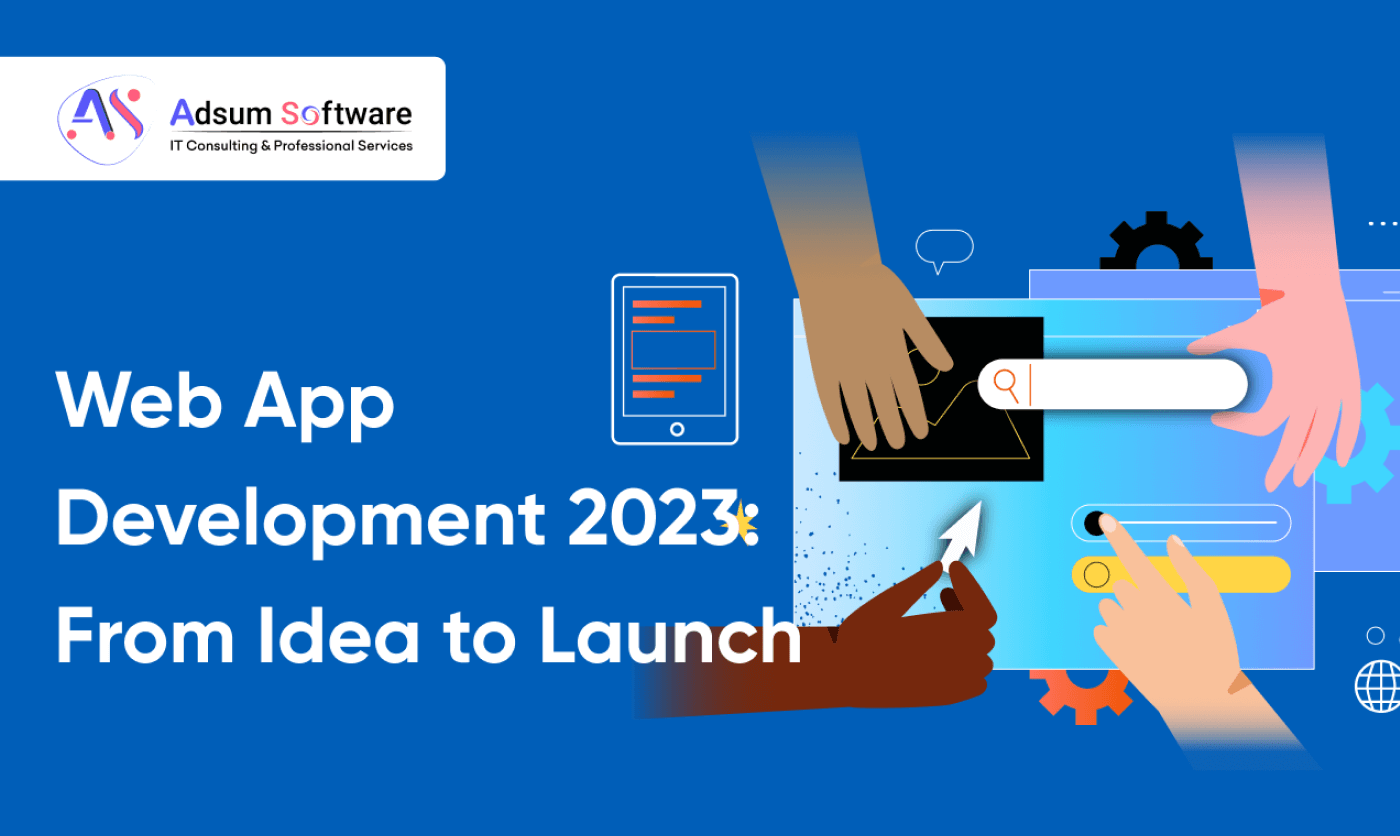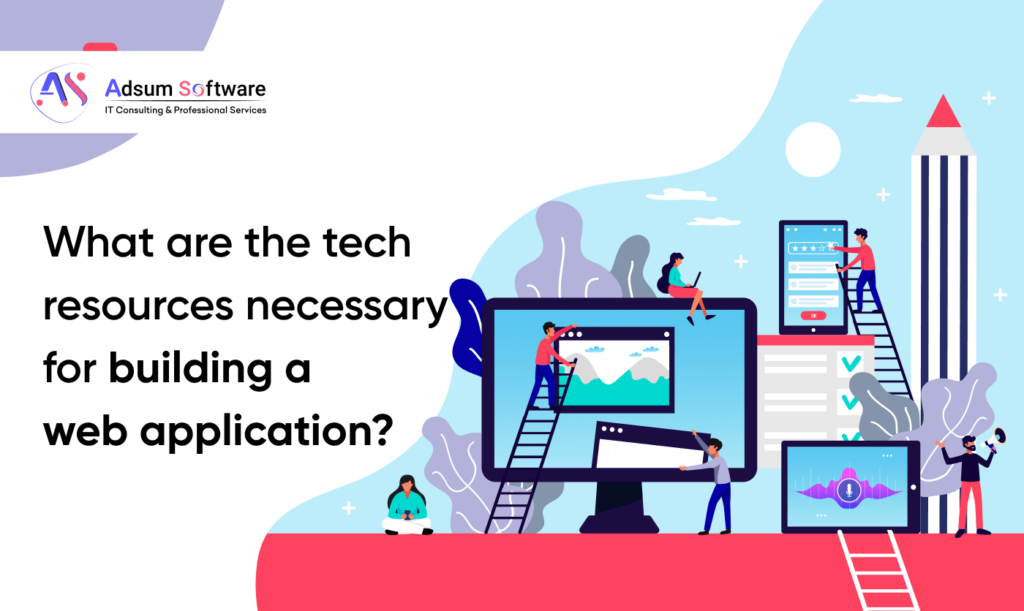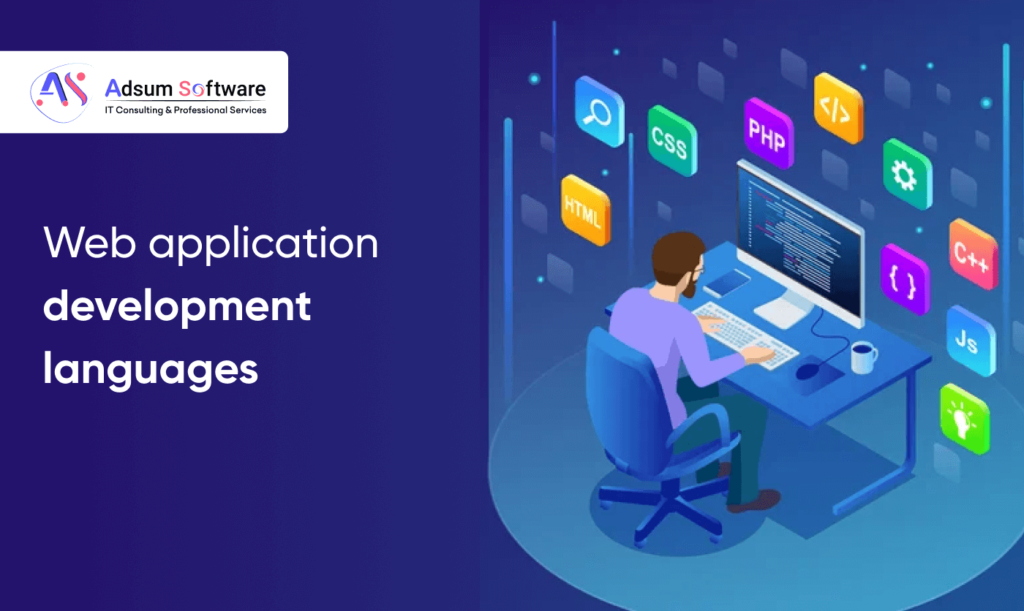Cookies help us to enhance your experience. By using the website for Adsum software, you consent to the gathering of data as set forth in our Cookie Policy.
Web App Development 2023: From Idea to Launch

Are you facing difficulty choosing to go for custom web app development for your product because of a lack of technical knowledge on its implementation?
Well! You’ve come to the right place!
This blog post provides a thorough overview of building a web application, covering important topics such as the process of web app development, the benefits of web apps, and the key factors to keep in mind for custom web application development in 2023 and beyond.

Table of Contents
Understanding the basics of Web Application development
Web app development involves creating internet platforms or applications using a server-client architecture. The development procedure involves uncovering the business idea, developing design documents, choosing a technical framework, implementing the code, conducting testing, and finally deploying the solution. It is essential for any company as it showcases its product portfolio and is a cost-effective way to reach clients through any platform.
We build web apps with dynamic web pages that allow user interaction and operate on a web server. Web applications are distinct in that they are stored online and can be accessed via a browser. Additionally, our web apps offer security and make it convenient to back up data.
For us, a web app should be a top priority as it can greatly increase clients’ current business traction, and brand recognition, showcase their company’s ideology, and secure a top position in their target market. That’s why many firms are investing in our web application development services by engaging professional web app developers.
What Advantages Does Building a Web Application Offer?

Our custom web apps come along with several key benefits –
- Increased reach: Our advanced web applications have worldwide accessibility, allowing users to access them from any device with an internet connection.
- Minimize Cost: We make a web-based applications that can help minimize expenses, thanks to its straightforward architecture, reduced system requirements for the user, and decreased support and upkeep needs. Additionally, it facilitates streamlining the client’s business processes, leading to added cost savings.
- Scalability: A common challenge faced is the inability of the software to accommodate growth as the business expands. We make web-based applications that are flexible and tailored to meet the client’s needs, allowing for scalability as the business grows.
- Improved User Experience: With a well-designed user interface and intuitive navigation, the web applications we provide give a better user experience than traditional software applications.
- Better Data Management: We make web apps that provide centralized data management and improve the accuracy and accessibility of data.
- Protected live data: Complex systems manage and store significant amounts of data using various systems. To address this, we make web-based applications that provide an additional layer of security by limiting access to the underlying servers and data.
- Increased Productivity: Our web applications can increase productivity and efficiency by automating tasks and providing users with easy-to-use tools.
- Easy Integration: We make web apps that can be integrated with other software applications, such as payment systems and databases, making it easy to automate processes and streamline workflows.
- Flexibility: Our web applications can be easily modified and updated, allowing businesses to respond quickly to changing requirements and market trends.
What are the technologies are necessary for building a web application?
Technology utilization depends on the web application’s unique requirements and the development team’s choices. But here, we give you the detail of some commonly used web app development technologies by us, including:

Front-end technologies
HTML, CSS, and Javascript form the basis of the front-end or client side of a web application. We used them to create the user interface and provide interactivity. Our web app developers often use front-end technologies, including Angular, React, Vue.js, and others.
Back-end technologies
The back-end or server side of a web app development is responsible for processing data, handling business logic, and serving the data to the front-end. The common back-end technologies we use include Node.js, Ruby on Rails, Django, ASP.NET, and others.
Database technologies
A web application typically requires a database to store data. Some popular database technologies we use to build web apps include MySQL, PostgreSQL, MongoDB, and others.
Server-side technologies
The operation of the web application’s backend code takes place on a web server. The web server technologies we use commonly include Apache, Nginx, and Microsoft IIS.
API Technologies
Web applications often rely on APIs to exchange data between the front-end and back-end or between different applications. We use some popular API technologies in web app development, including REST and GraphQL.
Cloud technologies
It is common knowledge that web applications can be deployed on cloud computing platforms like Amazon Web Services (AWS), Microsoft Azure, and Google Cloud Platform (GCP). We also provide leased cloud platforms for our web applications with scalable and flexible hosting solutions.
Web application development examples
The continued web app development remains a significant focus for companies of all sizes. There are numerous web-based applications available, and some of our top choices have greatly impacted the world in various ways, whether through their appearance and user experience, functionality, or security measures.
Let’s walk through a few examples of web applications that are used today:
- E-commerce websites: Online stores like Amazon, eBay, and Etsy are examples of e-commerce web applications that allow users to buy and sell goods and services online.
- Social media websites: Facebook, Twitter, and LinkedIn are popular examples of social media web applications that allow users to connect and share content.
- Project management tools: Trello, Asana, and Basecamp are web-based project management tools that allow teams to collaborate, organize tasks, and track progress.
- Online payment systems: PayPal, Stripe, and Square are examples of online payment systems that allow users to securely transfer money and make payments online.
- Healthcare applications: WebMD, Practo, and ZocDoc are examples of web applications that allow patients to access healthcare information, book appointments, and communicate with healthcare providers.
- Cloud storage services: Dropbox, Google Drive, and Microsoft OneDrive are examples of cloud storage services that allow users to store and access files online.
Web application development languages
In recent years, several new and advanced programming languages and technologies have emerged in the web application development space. Here are a few of the most popular ones that our skilled developers commonly use are:

- Node.js: Our skilled web app developers use Node.js, a server-side JavaScript runtime environment. It enables developers to build fast, scalable, and efficient web applications.
- React: We use React, a JavaScript library that helps build user interfaces that are widely used in web app development.
- Angular: We use Angular, a JavaScript framework, to build dynamic and complex web-based applications. Particularly, it is advantageous for constructing single-page applications.
- Vue.js: This progressive JavaScript framework we use for building user interfaces is known for its flexibility, simplicity, and performance.
- GraphQL: GraphQL is a powerful tool for API development that allows web app developers to specify the required data precisely, thereby avoiding the issue of under or over-fetching data in web applications.
- TypeScript: Also, use TypeScript, a statically typed superset of JavaScript. It provides improved type safety and more robust code structures, making it a popular choice for large-scale web app development.
- Rust: Rust is a systems programming language designed for safety, speed, and performance and is increasingly used for building web apps due to its ability to handle concurrency and memory management effectively.

Web application development tools
There are many tools used for web app development, here are some popular ones:
1. Integrated Development Environments (IDEs)
- Visual Studio Code
- Sublime Text
- Atom
- WebStorm
2. Project management tools
- Trello
- Asana
- Jira
3. Source control tools
- Git
- GitHub
- Bitbucket
4. Automation tools
- Grunt
- Gulp
- Webpack
5. CSS frameworks
- Bootstrap
- Foundation
- Materialize
6. JavaScript frameworks
- React
- Angular
- Vue
7. Backend frameworks
- Express.js
- Ruby on Rails
- Django
8. Database management systems
- MongoDB
- MySQL
- PostgreSQL
9. Cloud platforms
- Amazon Web Services (AWS)
- Microsoft Azure
- Google Cloud Platform (GCP)
10. API testing tools
- Postman
- SoapUI
- Rest-Assured
Web application development frameworks
Web app development frameworks are actively used to develop and maintain a large and supportive community of web apps. Framework provides many tools and features for building complex, scalable, and performant web applications.
The most advanced web app development frameworks that we widely use are:
- Ruby on Rails: A full-stack framework that provides a high-level of abstraction and convention over configuration, making it easy to make web apps quickly.
- Laravel: It is a PHP framework that has gained popularity due to its elegant syntax and a strong emphasis on application architecture, making it easier to build web apps that are robust and maintainable.
- Express: A minimalist Node.js framework that is fast, flexible, and ideal for building scalable and performance-critical web applications and APIs.
- Django: A high-level Python framework that provides a large set of built-in tools and a strong emphasis on security, making it a good choice for complex, data-driven web applications.
- ASP.NET: A Microsoft framework that provides a robust set of tools for building web applications and services and integrates well with other Microsoft technologies such as Azure and .NET Core.
Web application development platforms
Web application development platforms are cloud-based or on-premise software platforms that provide tools, frameworks, and infrastructure for building and deploying web applications. Some widely used web app development platforms include:
- Heroku: This is a type of cloud platform that we use for building, deploying, and managing web applications. This platform prioritizes ease of use and enhances developer productivity.
- AWS Elastic Beanstalk: This fully managed service is used for deploying, running, and scaling web applications and services, with automatic load balancing and scaling.
- Microsoft Azure: Microsoft Azure is a comprehensive cloud platform for building, deploying, and managing web applications and services, with a wide range of tools and services for web development.
- Google Cloud Platform (GCP): We use this platform for web app development and deployment of applications and services. It is also used for web and mobile app development tools, including App Engine and Firebase.
- Salesforce Lightning Platform: A cloud-based platform for building and deploying custom business applications, focusing on simplicity and ease of use for non-technical users.
6 Steps for Web application development process
The creation of web-based applications involves the application’s design, construction, and deployment to the internet through web app development. It involves several stages, including:
Stage 1: Requirements Gathering
At this stage of web app development, our dedicated and skilled development team works with the client to understand the requirements and goals of the project. Working at this stage involves:
- Defining the required features and functionalities.
- Determining the target audience.
- Setting project timelines and budgets.
Stage 2: Design and Prototyping
In this stage, our development team creates a visual representation of the web application, including the layout, UI, and overall look and feel. The process at hand encompasses the development of wireframes, mockups, and prototypes to comprehensively illustrate the app’s design and operation.
Stage 3: Development
During this stage, the development team writes and builds the application. This stage involves the creation of the back-end infrastructure, integrating APIs and other third-party services, and testing the application to ensure its functionality and performance.
Stage 4: Testing and Quality Assurance
Once the development stage is complete, the application undergoes testing and quality assurance to identify and resolve any bugs or issues. This phase involves both manual and automated testing to guarantee that the application operates correctly and satisfies the client’s specified needs.
Stage 5: Deployment
After that, we deploy the application to a web server and make it accessible to users over the internet.
Stage 6: Maintenance and Support
This is the final stage of the web app development process, which involves ongoing maintenance and support to ensure the application continues to function correctly and meets the client’s changing needs. In this stage, we fix bugs or issues that arise, update the application with new features and functionalities, and provide technical support to end-users.

What is the estimated time frame for the development of a web application?
The time taken by us to build a web app can vary greatly depending on several factors, including:
- Web application complexity
- size of our development team
- The approach adopted in web app development
- availability of resources
Typically, the development time taken by our team for a simple web application can range from a few weeks to a few months, while the development time for a complex web application can range from several months to a year or more. It’s crucial to remember that these are just rough approximations, and the actual development duration will significantly depend on the project’s specific requirements.
What is the estimated cost for building a web application?
Our cost of developing a web application can vary greatly depending on several factors, such as the project’s complexity, the number of features required, the development team’s experience and location, and the technology stack used.
The cost of developing a web app varies based on complexity but can range from thousands to hundreds of thousands of dollars.
In the end, the cost quoted for web application development will be dependent on the specific demands of the project. for this reason, it’s advisable to have an initial discussion to obtain a more precise evaluation.
Conclusion
Web app development is a unique software development branch that blends elements of websites and mobile apps.
There are various web apps, including progressive web apps, client-side web apps, server-side web apps, and single-page applications. We create a web app using front-end and back-end technologies, and the development process is similar to traditional web development.
You may already be familiar with several popular web apps in widespread use today.

FAQ
What tech stack do you use for web app development?
Our web app developers use the latest technologies and frameworks, such as React, Angular, Vue.js, Node.js, and Ruby on Rails, to develop high-performance web apps.
What measures do you take to ensure the quality of your web apps?
Our strict testing and quality assurance procedures guarantee that all web apps we develop meet the most demanding standards.
Can you handle projects of all sizes?
Yes, we have the expertise and resources to handle projects of any size, from small startups to large enterprises.
How do you keep clients updated throughout the web app development process?
We use a variety of communication tools, such as email, video conferencing, and project management software, to keep our clients informed and updated throughout the development process.
How can I speed up the launch of my web application?
Several factors impact the time to market a product, but adopting a product-focused mindset and an Agile development approach can help expedite the process.
Our web app development offers a quicker path to market than mobile apps as they require shorter development time and can reach both Apple and Android users simultaneously without requiring separate cross-platform packaging or launch processes.
Are you ready to elevate your idea to the next stage? Let our team of experts bring your web app vision to life in 2023! We’ve Got You Covered from Concept to Deployment. Let’s make it happen!
Let’s create a measurable impact on your business.
LET’S TALK AND GET STARTEDWe love to hear the ideas of startups and flawlessly carry them out to establish them as a Brand.
We provide a FREE CONSULTATION for 60 minutes!
 Call
Call adsum.software
adsum.software

 Mobile App Development
Mobile App Development
 Android App Development
Android App Development
 iOS App Development
iOS App Development
 Web App Development
Web App Development
 UI/UX Design
UI/UX Design
 Dedicated Development Team
Dedicated Development Team

